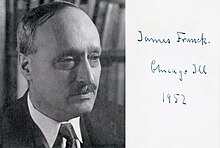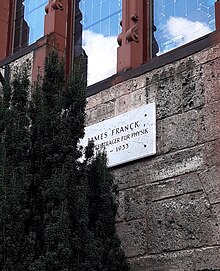James Franck
James Franck (born August 26, 1882 in Hamburg ; † May 21, 1964 in Göttingen ) was a German experimental physicist who later emigrated to the United States as a Jewish refugee from the Nazis and took American citizenship. In 1925 he received the Nobel Prize with Gustav Hertz . Franck is best known for the Franck-Hertz experiment to confirm quantum theory and the Franck report . In the latter, he tried to dissuade the President of the United States from using the atomic bomb in the war against Japan.
Life
James Franck was the eldest son of the Jewish banker Jacob Franck and his wife Rebecka geb. Printer. Franck grew up in Hamburg, where he passed his matriculation examination at Wilhelm-Gymnasium in 1902 . He then briefly studied chemistry at Heidelberg University , then physics in Berlin under Paul Drude and Emil Warburg , among others , where he obtained his doctorate in 1906 from Warburg. He was then assistant in the Physikalischer Verein in Frankfurt am Main and shortly afterwards in Berlin with Heinrich Rubens from 1911 private lecturer and from 1916 associate professor.
In 1911 Franck married Ingrid Josefson. The couple had two daughters, Dagmar and Lisa.

Franck's fame as a physicist is mainly based on the Franck-Hertz experiment carried out together with Gustav Hertz in the years 1912–1914 , which confirmed Bohr's atomic model . For this, the two physicists received the 1925 Nobel Prize , which was awarded to them on November 11, 1926.
During the First World War Franck served voluntarily in the German army (among other things in the Pioneer Regiment 35 ) and received the Iron Cross First Class after a gas attack in 1917 in which he was seriously injured . Like Otto Hahn and Gustav Hertz , he was one of the officers who supervised the use of poison gas at the front under Fritz Haber .
From 1918 he was head of the physics department at the Kaiser Wilhelm Institute for Physical Chemistry in Berlin-Dahlem under Fritz Haber . Franck was appointed professor of experimental physics at the University of Göttingen in 1920 , where he worked with Max Born and his students Patrick Maynard, Stuart Blackett , Edward Condon , Friedrich Georg Houtermans , Friedrich Hund , Hans Kopfermann , Werner Kroebel , Heinz Maier-Leibnitz , and Robert Oppenheimer , Charlotte Riefenstahl and Eugene Rabinowitch worked. One of his employees was the physicist Hertha Sponer . Franck was director of the Second Institute for Experimental Physics in Göttingen. With Condon he then established the Franck-Condon principle . In 1929 he was elected to the American Academy of Arts and Sciences and a corresponding member of the Prussian Academy of Sciences .
When the National Socialists came to power, Franck caused a sensation on April 17, 1933 when he resigned his professorship at the University of Göttingen in protest against the " removal of all Jews from state positions ", although he was a "front-line fighter" because of an initial exception to this law. would have been spared from this law at first. Franck complained in a letter to the rector of the university, the content of which he also brought to the attention of the Göttinger Tageblatt, that Germans of Jewish descent were treated as strangers and enemies of the fatherland. He concluded by saying that there was an inner need for him to remain a civil servant because he felt that he was being treated dishonorably. This prompted a group of 42 university professors to rally in the Göttinger Zeitung on April 24, 1933, in which they described Franck's declaration as an “act of sabotage” which could “make the work of the national government considerably more difficult”. Therefore they called on the government to accelerate the application of anti-Jewish discrimination. In the same year Franck emigrated to Baltimore , where he immediately became a professor at Johns Hopkins University . After a year as a visiting professor in Copenhagen in 1934/35 , he returned to Baltimore in 1935 as a professor at Johns Hopkins University and in 1938 as professor of physical chemistry at the University of Chicago . In 1947 he was retired there.
In Chicago, Franck came into contact with the Manhattan Project from 1942 as director of the chemistry department of the metallurgy laboratory : after taking US citizenship in July 1941, he worked on the plutonium extraction, but had moral concerns about Germany's surrender the use of atomic weapons, which he finally put down together with other scientists in the Franck Report named after him and personally handed over to the American Secretary of War on June 11, 1945, in order to prevent the atomic bomb from being dropped on Japan.
In 1942 his membership in the Prussian Academy of Sciences was revoked. This withdrawal was reversed in 1946. Since 1937 he was an elected member of the American Philosophical Society . In 1944 Franck was elected to the National Academy of Sciences . In 1951 he declared himself quitting the in the DDR -based Academy of Sciences in protest against a congratulatory telegram, which the Academy president John Stroux of Stalin had sent.
In his second marriage in 1946, Franck married his former assistant in Göttingen, Hertha Sponer , who is now a professor of physics at Duke University in North Carolina .
In 1951 he was awarded the Max Planck Medal . Franck returned to Germany for the first time in 1953 when he was awarded honorary citizenship of the city of Göttingen.
In Chicago, after the Second World War, he mainly worked in the field of photosynthesis , for which he received the Rumford Prize of the American Academy of Arts and Sciences in 1955 . In 1958 Franck became a member and honorary member of the Leopoldina , in 1964 a member of the Royal Society London .
He died of a heart attack on May 21, 1964 while visiting Göttingen. Before that, he had met Otto Hahn . His grave is in Chicago next to that of his wife.
The moon crater Franck is named after him. In 2007 the asteroid (160512) Franck-Hertz was named after him and Gustav Hertz .
useful information

In 1896, the almost 14-year-old Franck went to the physical calibration office in Hamburg. There he asked about the new X-ray equipment. He had heard of the " x-rays " that were discovered a few months ago, broke his arm and wanted to see whether his bones would grow back together properly. The apparatus was set up and he was allowed to have his arm x-rayed with the X-ray apparatus that had just arrived. This was the first X-ray taken in the Hanseatic city.
When German troops occupied the Danish capital Copenhagen in April 1940 during the Second World War , the Hungarian chemist George de Hevesy , who worked in Niels Bohr's laboratory, dissolved the gold Nobel Prize medals of the German physicists Max von Laue and James Franck in aqua regia to make them so to protect against access by the German occupiers. From 1933 von Laue and Franck were in opposition to National Socialism in Germany and had therefore entrusted their medals to Niels Bohr in order to prevent confiscation in Germany. After the end of the war, de Hevesy extracted the gold dissolved in the aqua regia and gave it to the Royal Swedish Academy of Sciences, which made new medals from it and handed it back to von Laue and Franck.
The physicist Frank von Hippel (* 1937) is a grandson of James Franck.
literature
- Markus Wegner , A memory of James Franck ... there must also be people of my kind. In: Wilhelm-Gymnasium Hamburg 1881-2006. Festschrift for the 125th anniversary 2006 , Hamburg 2006.
- Jost Lemmerich , upright in the storm of time. The physicist James Franck, 1882–1964 . GNT-Verlag, Diepholz / Stuttgart / Berlin 2007, ISBN 978-3-928186-83-4 . (English translation Science and Conscience. The Life of James Franck, Stanford University Press 2011)
Web links
- Information from the Nobel Foundation on the award ceremony for James Franck in 1925
- Member entry of James Franck (with picture and CV) at the German Academy of Natural Scientists Leopoldina , accessed on April 17, 2019.
- Literature by and about James Franck in the catalog of the German National Library
- Oral History Interview 1962 with Maria Goeppert-Mayer and Thomas Kuhn , APS
- Stuart Rice, Joshua Jortner: James Franck, Biographical Memoirs Nat. Acad. Science, pdf
- James Franck Papers, University of Chicago Library
Individual evidence
- ↑ see birth register entry at Hamburg registry office 02 no. 4103/1882. For the parents' marriage register entry, see Hamburg registry office 02 No. 919/1880.
- ↑ All information on the subject of "Academy of Sciences" from Matthias Judt (ed.): GDR history in documents, Federal Agency for Civic Education, Bonn 1998, p. 276 f.
- ^ Jews in Germany . In: Nature . tape 131 , no. 3313 , April 1933, ISSN 0028-0836 , p. 612–612 , doi : 10.1038 / 131612b0 ( rdcu.be [accessed February 10, 2019]).
- ↑ James Franck to the Rector of the University of Göttingen from April 1, 1933, published online on the homepage of the University of Göttingen here , accessed on March 9, 2014.
- ↑ Martin Sabrow : The German University in National Socialism . In Christoph Cornelißen; Carsten Mish Hrsg .: Science at the limit. The University of Kiel under National Socialism. Klartext, Essen 2009, ISBN 978-3-8375-0240-4 , page 384. ( Communications from the Society for Kiel City History. Vol. 86).
- ^ Member History: James Franck. American Philosophical Society, accessed August 10, 2018 .
- ↑ see death register entry at the Göttingen registry office No. 844/1964.
- ^ Obituary for James Franck, published on June 10, 1964 by Walther Zimmerli , Rector of the Georg-August-Universität Göttingen
- ^ Jost Lemmerich: Science and Conscience: The Life of James Franck . Stanford University Press, Aug 10, 2011, ISBN 978-0-8047-7909-8 , p. 386.
- ^ The Minor Planet Circulars / Minor Planets and Comets. (PDF) Minor Planet Center, Smithsonian Astrophysical Observatory, September 26, 2007, p. 118 , accessed on May 24, 2020 .
| personal data | |
|---|---|
| SURNAME | Franck, James |
| BRIEF DESCRIPTION | German-American physicist |
| DATE OF BIRTH | August 26, 1882 |
| PLACE OF BIRTH | Hamburg |
| DATE OF DEATH | May 21, 1964 |
| Place of death | Goettingen |



